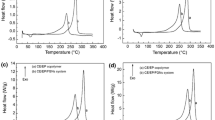Abstract
In this work, graphene–epoxy nanocomposites are produced for two different graphene fractions (0.1 and 0.5 wt%). Three-roll milling is used as the main strategy to achieve a homogeneous dispersion and prevent agglomeration. To improve the interfacial bonding between graphene nanoflakes (GNF) and epoxy matrix, GNFs are functionalized using Triton X-100 as a surfactant. The effectiveness of this functionalization is investigated using Raman spectroscopy and Fourier transform infrared spectroscopy (FT-IR). These spectroscopy results show that the Triton X-100 molecules are successfully adsorbed on the surface of GNFs. To investigate the total viscoelastic–viscoplastic behavior of the nanocomposites, compression tests at three different quasistatic strain rates (1.E-1, 1.E-2, 1.E-3 /s), creep tests at two different stress levels and relaxation tests at two different strain levels are performed. The total time-dependent mechanical behavior of the produced nanocomposites is therefore characterized comprehensively. Elasticity-modulus values obtained from compression tests increased up to 29% and yield stress increased up to 18%. In creep tests, it is observed that the creep strain decreased 32% and 65% at 50 and 100 MPa stress levels, respectively, at 0.1 wt% functionalized graphene flakes (f-GNF)–epoxy nanocomposite. At the same time, with the addition of 0.1 wt% f-GNF to epoxy, during relaxation tests, the stress drop decreased up to 47% compared to pure epoxy at a 3.16% constant strain level. Both creep and relaxation resistance improved when compared to pure epoxy. This total improvement in the mechanical behaviors is explained with the effective dispersion of the GNFs and also a strong interface between the GNFs and the epoxy matrix.
















Similar content being viewed by others

Data Availability
Data will be made available on reasonable request.
References
Acar, A., Çolak, Ö.Ü., Uzunsoy, D.: Synthesis and characterization of graphene-epoxy nanocomposites. Mater. Test. 57, 1001–1005 (2015). https://doi.org/10.3139/120.110804
Ahmadi-Moghadam, B., Taheri, F.: Effect of processing parameters on the structure and multi-functional performance of epoxy/GNP-nanocomposites. J. Mater. Sci. 49, 6180–6190 (2014). https://doi.org/10.1007/s10853-014-8332-y
Anwer, M.A.S., Wang, J., Naguib, H.E.: 1D/2D CNF/GNP hybrid nanofillers: evaluation of the effect of surfactant on the morphological, mechanical, fracture, and thermal characteristics of their nanocomposites with epoxy resin. Ind. Eng. Chem. Res. 58, 8131–8139 (2019). https://doi.org/10.1021/acs.iecr.9b00956
Bakbak, O., Birkan, B.E., Acar, A., Colak, O.: Mechanical characterization of Araldite LY 564 epoxy: creep, relaxation, quasi-static compression and high strain rate behaviors. Polym. Bull. (2021). https://doi.org/10.1007/s00289-021-03624-x
Balandin, A.A., Ghosh, S., Bao, W., Calizo, I., Teweldebrhan, D., Miao, F., Lau, C.N.: Superior thermal conductivity of single-layer graphene. Nano Lett. 8, 902–907 (2008). https://doi.org/10.1021/nl0731872
Carrasco, P.M., Montes, S., García, I., Borghei, M., Jiang, H., Odriozola, I., Cabañero, G., Ruiz, V.: High-concentration aqueous dispersions of graphene produced by exfoliation of graphite using cellulose nanocrystals. Carbon 70, 157–163 (2014). https://doi.org/10.1016/j.carbon.2013.12.086
Chandrasekaran, S., Seidel, C., Schulte, K.: Preparation and characterization of graphite nano-platelet (GNP)/epoxy nano-composite: mechanical, electrical and thermal properties. Eur. Polym. J. 49, 3878–3888 (2013). https://doi.org/10.1016/j.eurpolymj.2013.10.008
Chandrasekaran, S., Sato, N., Tölle, F., Mülhaupt, R., Fiedler, B., Schulte, K.: Fracture toughness and failure mechanism of graphene based epoxy composites. Compos. Sci. Technol. 97, 90–99 (2014). https://doi.org/10.1016/j.compscitech.2014.03.014
Chen, Y., Zhao, H., Sheng, L., Yu, L., An, K., Xu, J., Ando, Y., Zhao, X.: Mass-production of highly-crystalline few-layer graphene sheets by arc discharge in various H2–inert gas mixtures. Chem. Phys. Lett. 538, 72–76 (2012). https://doi.org/10.1016/j.cplett.2012.04.020
Colak, O.U., Cakir, Y.: Material model parameter estimation with genetic algorithm optimization method and modeling of strain and temperature dependent behavior of epoxy resin with cooperative-VBO model. Mech. Mater. 135, 57–66 (2019). https://doi.org/10.1016/j.mechmat.2019.04.023
Colak, Ö.U., Bahlouli, N., Uzunsoy, D., Francart, C.: High strain rate behavior of graphene-epoxy nanocomposites. Polym. Test. 81, 106219 (2020). https://doi.org/10.1016/j.polymertesting.2019.106219
Cotul, U., Parmak, E.D.S., Kaykilarli, C., Saray, O., Colak, O., Uzunsoy, D.: Development of high purity, few-layer graphene synthesis by electric arc discharge technique. Acta Phys. Pol. A 134, 289–291 (2018). https://doi.org/10.12693/APhysPolA.134.289
Dai, J., Peng, C., Wang, F., Zhang, G., Huang, Z.: Effects of functionalized graphene nanoplatelets on the morphology and properties of phenolic resins. J. Nanomater. 2016, 1–7 (2016). https://doi.org/10.1155/2016/3485167
Geng, Y., Liu, M.Y., Li, J., Shi, X.M., Kim, J.K.: Effects of surfactant treatment on mechanical and electrical properties of CNT/epoxy nanocomposites. Composites, Part A, Appl. Sci. Manuf. 39, 1876–1883 (2008). https://doi.org/10.1016/j.compositesa.2008.09.009
Georgakilas, V., Tiwari, J.N., Kemp, K.C., Perman, J.A., Bourlinos, A.B., Kim, K.S., Zboril, R.: Noncovalent functionalization of graphene and graphene oxide for energy materials, biosensing, catalytic, and biomedical applications. Chem. Rev. 116, 5464–5519 (2016). https://doi.org/10.1021/acs.chemrev.5b00620
Hashim, U.R., Jumahat, A.: Improved tensile and fracture toughness properties of graphene nanoplatelets filled epoxy polymer via solvent compounding shear milling method. Mater. Res. Express 6, 025303 (2018). https://doi.org/10.1088/2053-1591/aaeaf0
Imran, K.A., Shivakumar, K.N.: Enhancement of electrical conductivity of epoxy using graphene and determination of their thermo-mechanical properties. J. Reinf. Plast. Compos. 37, 118–133 (2018). https://doi.org/10.1177/0731684417736143
Jang, J.I.: New Developments in Photon and Materials Research. Nova Science Publishers, Incorporated, ??? (2013)
Jian, W., Lau, D.: Creep performance of CNT-based nanocomposites: a parametric study. Carbon 153, 745–756 (2019). https://doi.org/10.1016/j.carbon.2019.07.069
Kaykılarlı, C., Uzunsoy, D., Parmak, E.D.Ş., Fellah, M.F., Çakır, Ö.Ç.: Boron and nitrogen doping in graphene: an experimental and density functional theory (DFT) study. Nano Express 1, 010027 (2020). https://doi.org/10.1088/2632-959X/ab89e9
Khabaz-Aghdam, A., Behjat, B., da Silva, L.F.M., Marques, E.A.S.: A new theoretical creep model of an epoxy-graphene composite based on experimental investigation: effect of graphene content. J. Compos. Mater. 54, 2461–2472 (2020). https://doi.org/10.1177/0021998319895806
Kudin, K.N., Ozbas, B., Schniepp, H.C., Prud’homme, R.K., Aksay, I.A., Car, R.: Raman spectra of graphite oxide and functionalized graphene sheets. Nano Lett. 8, 36–41 (2008). https://doi.org/10.1021/nl071822y
Lee, H.-N., Paeng, K., Swallen, S.F., Ediger, M.D.: Direct measurement of molecular mobility in actively deformed polymer glasses. Science 323, 231–234 (2009). https://doi.org/10.1126/science.1165995
Li, Q., Church, J.S., Kafi, A., Naebe, M., Fox, B.L.: An improved understanding of the dispersion of multi-walled carbon nanotubes in non-aqueous solvents. J. Nanopart. Res. 16, 2513 (2014). https://doi.org/10.1007/s11051-014-2513-0
Li, Y., Tang, J., Huang, L., Wang, Y., Liu, J., Ge, X., Tjong, S.C., Li, R.K.Y., Belfiore, L.A.: Facile preparation, characterization and performance of noncovalently functionalized graphene/epoxy nanocomposites with poly(sodium 4-styrenesulfonate). Composites, Part A, Appl. Sci. Manuf. 68, 1–9 (2015). https://doi.org/10.1016/j.compositesa.2014.09.016
Malysheva, G.V., Akhmetova, E.S., Marycheva, A.N.: Estimation of glass transition temperature of polysulfone-modified epoxy binders. Glass Phys. Chem. 40, 543–548 (2014). https://doi.org/10.1134/S1087659614050095
Martin-Gallego, M., Yuste-Sanchez, V., Sanchez-Hidalgo, R., Verdejo, R., Lopez-Manchado, M.A.: Epoxy nanocomposites filled with carbon nanoparticles. Chem. Rec. 18, 928–939 (2018). https://doi.org/10.1002/tcr.201700095
McAllister, M.J., Li, J.-L., Adamson, D.H., Schniepp, H.C., Abdala, A.A., Liu, J., Herrera-Alonso, M., Milius, D.L., Car, R., Prud’homme, R.K., Aksay, I.A.: Single sheet functionalized graphene by oxidation and thermal expansion of graphite. Chem. Mater. 19, 4396–4404 (2007). https://doi.org/10.1021/cm0630800
Mohd Amran, N.A., Ahmad, S., Chen, R.S., Shahdan, D., Flaifel, M.H., Omar, A.: Assessment of mechanical and electrical performances of polylactic acid/liquid natural rubber/graphene platelets nanocomposites in the light of different graphene platelets functionalization routes. Macromol. Chem. Phys. 222, 2100185 (2021). https://doi.org/10.1002/macp.202100185
Moriche, R., Prolongo, S.G., Sánchez, M., Jiménez-Suárez, A., Sayagués, M.J., Ureña, A.: Morphological changes on graphene nanoplatelets induced during dispersion into an epoxy resin by different methods. Composites, Part B, Eng. 72, 199–205 (2015). https://doi.org/10.1016/j.compositesb.2014.12.012
Ni, Z., Wang, Y., Yu, T., Shen, Z.: Raman spectroscopy and imaging of graphene. Nano Res. 1, 273–291 (2008). https://doi.org/10.1007/s12274-008-8036-1
Papanicolaou, G.C., Xepapadaki, A.G., Drakopoulos, E.D., Papaefthymiou, K.P., Portan, D.V.: Interphasial viscoelastic behavior of CNT reinforced nanocomposites studied by means of the concept of the hybrid viscoelastic interphase. J. Appl. Polym. Sci. 124, 1578–1588 (2012). https://doi.org/10.1002/app.35202
Poutrel, Q.-A., Wang, Z., Wang, D., Soutis, C., Gresil, M.: Effect of pre and post-dispersion on electro-thermo-mechanical properties of a graphene enhanced epoxy. Appl. Compos. Mater. 24, 313–336 (2017). https://doi.org/10.1007/s10443-016-9541-0
Prolongo, S.G., Jimenez-Suarez, A., Moriche, R., Ureña, A.: In situ processing of epoxy composites reinforced with graphene nanoplatelets. Compos. Sci. Technol. 86, 185–191 (2013). https://doi.org/10.1016/j.compscitech.2013.06.020
Qamar, S., Yasin, S., Ramzan, N., Iqbal, T., Akhtar, M.N.: Preparation of stable dispersion of graphene using copolymers: dispersity and aromaticity analysis. Soft Mater. 17, 190–202 (2019). https://doi.org/10.1080/1539445X.2019.1583673
Shadlou, S., Ahmadi-Moghadam, B., Taheri, F.: The effect of strain-rate on the tensile and compressive behavior of graphene reinforced epoxy/nanocomposites. Mater. Des. 59, 439–447 (2014). https://doi.org/10.1016/j.matdes.2014.03.020
Tan, H., Jiang, L.Y., Huang, Y., Liu, B., Hwang, K.C.: The effect of van der Waals-based interface cohesive law on carbon nanotube-reinforced composite materials. Compos. Sci. Technol. 67, 2941–2946 (2007). https://doi.org/10.1016/j.compscitech.2007.05.016
Tang, L.-C., Wang, X., Gong, L.-X., Peng, K., Zhao, L., Chen, Q., Wu, L.-B., Jiang, J.-X., Lai, G.-Q.: Creep and recovery of polystyrene composites filled with graphene additives. Compos. Sci. Technol. 91, 63–70 (2014). https://doi.org/10.1016/j.compscitech.2013.11.028
Wan, Y.-J., Tang, L.-C., Yan, D., Zhao, L., Li, Y.-B., Wu, L.-B., Jiang, J.-X., Lai, G.-Q.: Improved dispersion and interface in the graphene/epoxy composites via a facile surfactant-assisted process. Compos. Sci. Technol. 82, 60–68 (2013). https://doi.org/10.1016/j.compscitech.2013.04.009
Wang, X., Jin, J., Song, M.: An investigation of the mechanism of graphene toughening epoxy. Carbon 65, 324–333 (2013). https://doi.org/10.1016/j.carbon.2013.08.032
Wang, F., Drzal, L.T., Qin, Y., Huang, Z.: Mechanical properties and thermal conductivity of graphene nanoplatelet/epoxy composites. J. Mater. Sci. 50, 1082–1093 (2015a). https://doi.org/10.1007/s10853-014-8665-6
Wang, X., Gong, L.-X., Tang, L.-C., Peng, K., Pei, Y.-B., Zhao, L., Wu, L.-B., Jiang, J.-X.: Temperature dependence of creep and recovery behaviors of polymer composites filled with chemically reduced graphene oxide. Composites, Part A, Appl. Sci. Manuf. 69, 288–298 (2015b). https://doi.org/10.1016/j.compositesa.2014.11.031
Wu, Y., Wang, B., Ma, Y., Huang, Y., Li, N., Zhang, F., Chen, Y.: Efficient and large-scale synthesis of few-layered graphene using an arc-discharge method and conductivity studies of the resulting films. Nano Res. 3, 661–669 (2010). https://doi.org/10.1007/s12274-010-0027-3
Yang, J., Zhang, Z., Friedrich, K., Schlarb, A.K.: Creep resistant polymer nanocomposites reinforced with multiwalled carbon nanotubes. Macromol. Rapid Commun. 28, 955–961 (2007). https://doi.org/10.1002/marc.200600866
Zandiatashbar, A., Picu, C.R., Koratkar, N.: Control of epoxy creep using graphene. Small 8, 1676–1682 (2012). https://doi.org/10.1002/smll.201102686
Zhang, W., Joshi, A., Wang, Z., Kane, R.S., Koratkar, N.: Creep mitigation in composites using carbon nanotube additives. Nanotechnology 18, 185703 (2007). https://doi.org/10.1088/0957-4484/18/18/185703
Zhang, G., Wang, F., Dai, J., Huang, Z.: Effect of functionalization of graphene nanoplatelets on the mechanical and thermal properties of silicone rubber composites. Materials 9, 92 (2016). https://doi.org/10.3390/ma9020092
Acknowledgements
We thank Ozberk Oztürk for performing Raman spectra and FT-IR tests.
Funding: This work is supported by TUBİTAK. Project number: 119M088.
Author information
Authors and Affiliations
Corresponding author
Additional information
Publisher’s Note
Springer Nature remains neutral with regard to jurisdictional claims in published maps and institutional affiliations.
Rights and permissions
About this article
Cite this article
Colak, O.U., Birkan, B., Bakbak, O. et al. Functionalized graphene–epoxy nanocomposites: experimental investigation of viscoelastic and viscoplastic behaviors. Mech Time-Depend Mater 27, 185–205 (2023). https://doi.org/10.1007/s11043-021-09530-z
Received:
Accepted:
Published:
Issue Date:
DOI: https://doi.org/10.1007/s11043-021-09530-z



